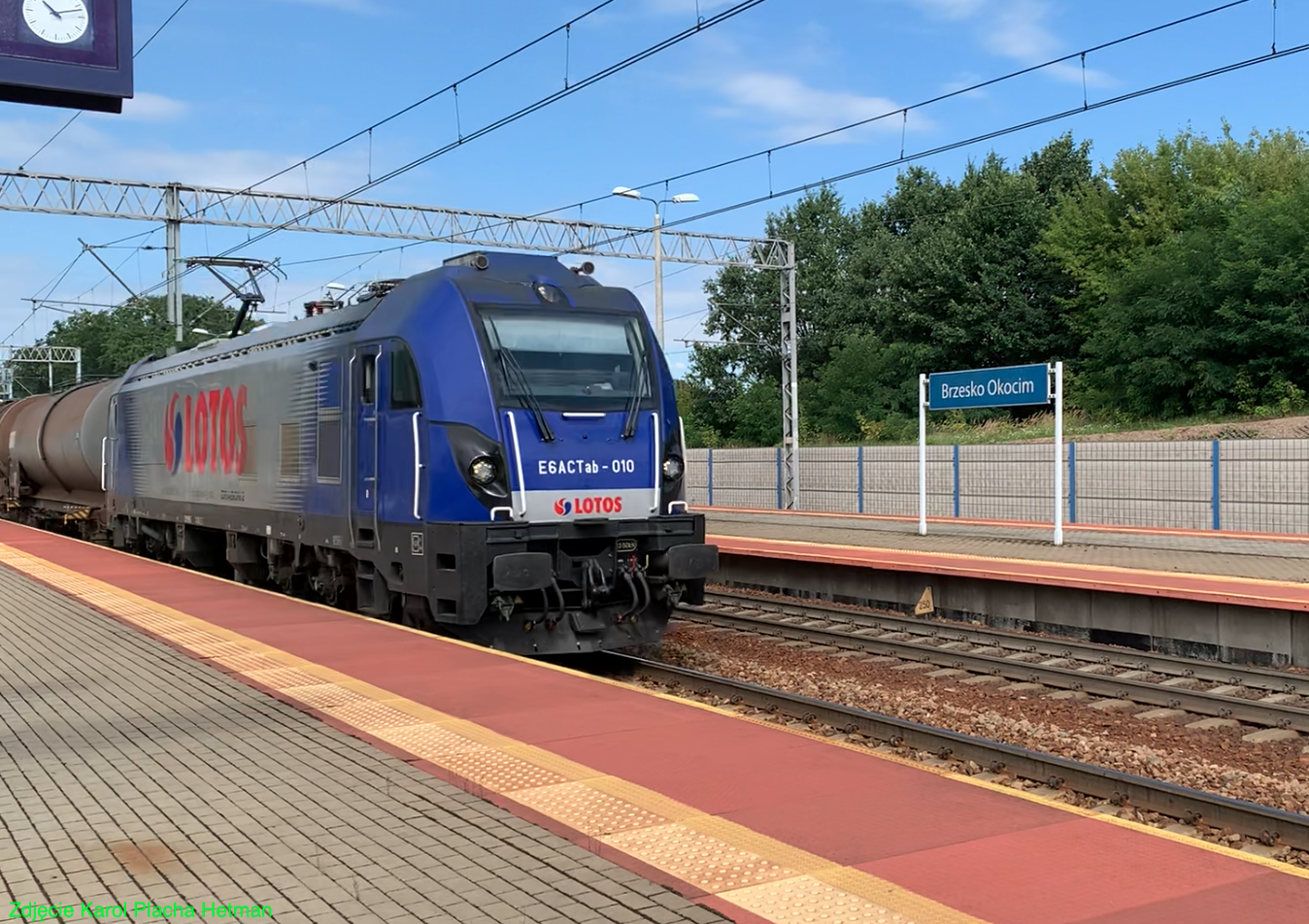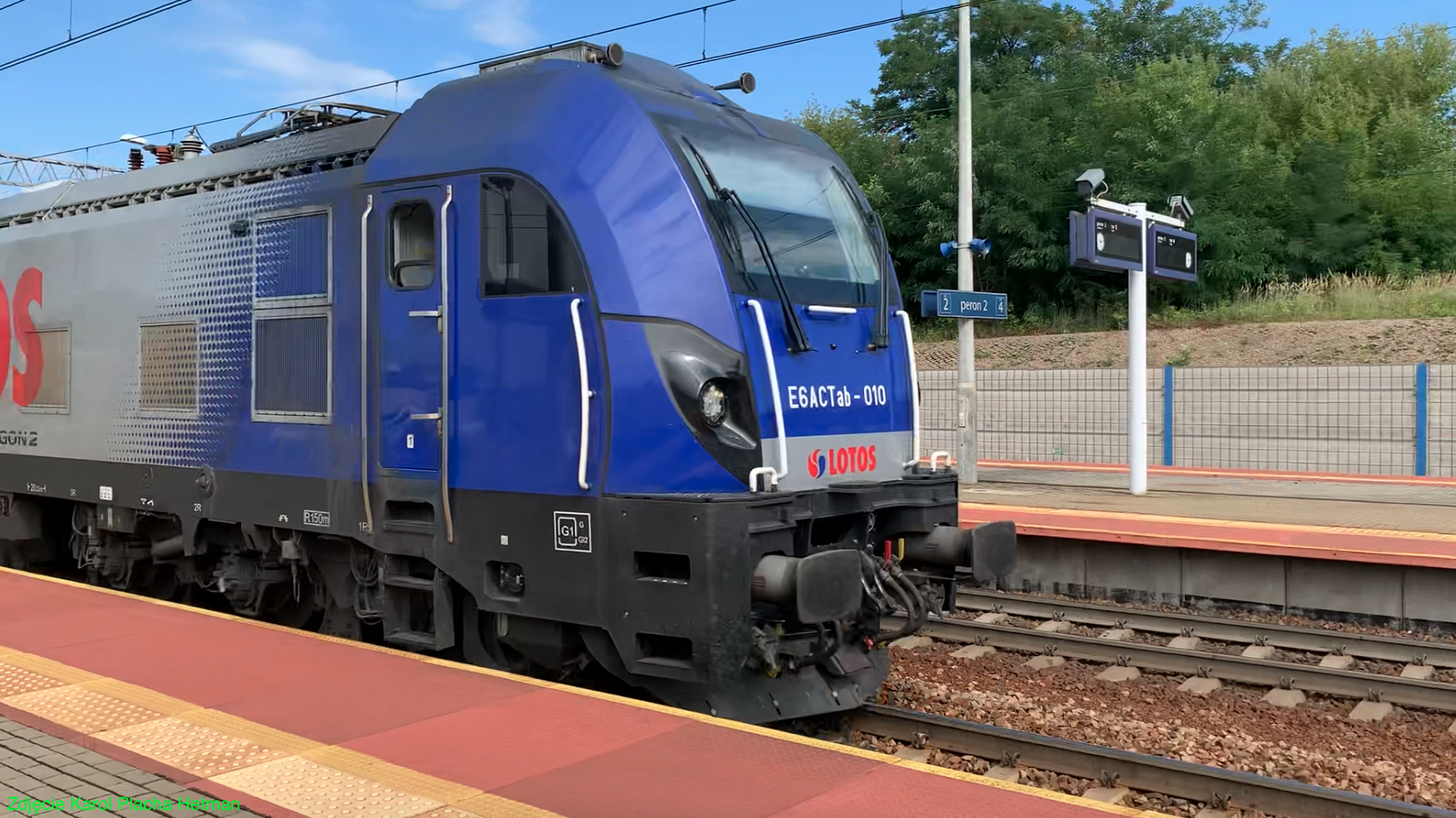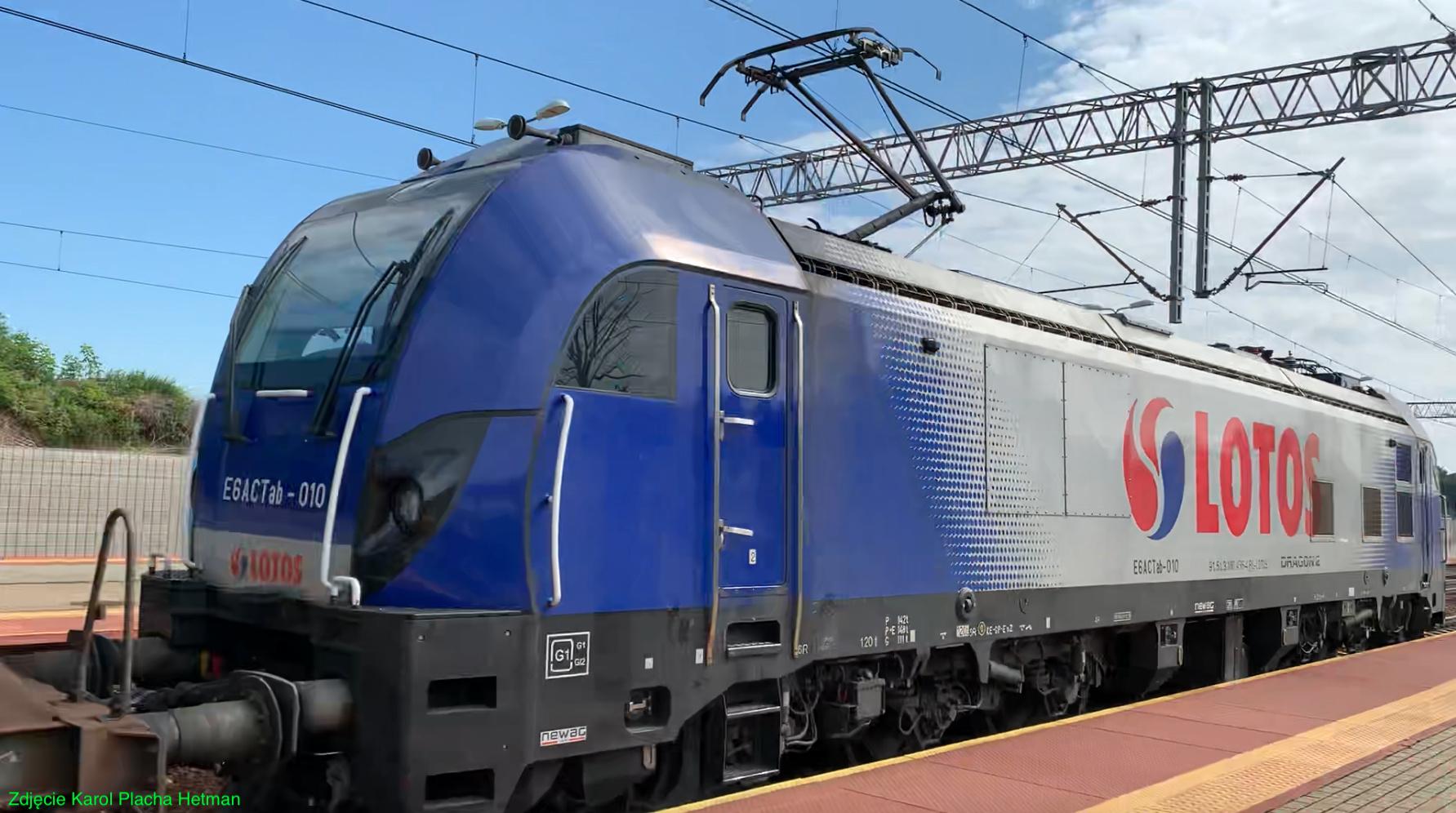Kraków 2024-01-18
NEWAG E6ACTab-010 Dragon 2 electric freight locomotive.



Newag Dragon is a family of six-axle electric locomotives designed to drive heavy freight trains weighing up to 4,500 tons. Dragon is a popular trade name of this locomotive. Dragon is a new quality among freight locomotives, especially adapted to Polish conditions. The E6ACT Dragon locomotive also has the PKP series designation ET25 and is the first new Polish freight locomotive after ET22, the production of which ended in 1989. Dragon is characterized by high pulling force up to 374 kN, safe use, attractive price, economical use, rich equipment and failure-free operation.
The first Dragon locomotive was built in 2009 in ZNLE Gliwice. The Electric Locomotive Repair Plant was in cooperation with NEWAG, which is based in Nowy Sącz. The Newag Dragon locomotive was produced by NEWAG Gliwice from 2009 to 2016, and from 2017 by Newag Nowy Sącz. By 2021, a total of over 50 locomotives in many versions have been produced and are operated by Polish freight carriers.
Construction development.
The basic locomotive in Poland was the ET22, of which 1,207 units were built by 1989 at PaFaWag in Wrocław. Then, until 1997, EP09 passenger electric locomotives were built there. Polish-Italian universal two-system EU43 and single-system electric locomotives EU11 were also produced. Production lasted until 2002, when the PaFaWag plant no longer existed and the Adtranz company operated. However, these electric locomotives did not hit Polish tracks because they were too expensive. In 2002, the Adtranz - PaFaWag factory was taken over by the Bombardier concern, which decided not to produce complete electric locomotives in the Wrocław plant. So, since 2002, there has been no manufacturer of electric locomotives in Poland.
This situation was not accepted by Poland. In 2006, the Ministry of Science and several research and development institutions decided to develop a new Polish electric locomotive for heavy freight trains. At the same time, it was to be an electric locomotive that could be operated on more worn tracks, so it was assumed that the locomotive would have a Co'Co' axle system. New traction engines were also designed. The first locomotive is powered by 6 STX500-4A electric motors (manufacturer EMIT) with a power of 834 kW each. The next ones use ABB AMXL450 engines with a power of 837 kW.
In 2009, the E6ACT-001 Dragon prototype was presented at the Trako railway fair in Gdańsk. It was the first Polish locomotive since 1990, when the EM10 locomotive (HCP 405E) premiered. In 2010, tests of the Dragon locomotive began on the test track near Żmigród in Lower Silesia. In 2010, the locomotive was presented at the InnoTrans fair in Berlin. The locomotive has been approved for rail traffic in Poland. In 2011, the following transport companies were interested in the locomotive: STK, PKP Cargo, Pol-Miedź Trans, Lotos Kolej, Freightliner.
The success of the Dragon locomotive, as well as changes in regulations, resulted in the development of the Dragon 2 version in 2018. The first locomotive of this version was marked E6ACTa-001. The locomotive passed the tests and received a certificate. Dragon 2 is the first Polish locomotive equipped with SiC (silicon carbide) power electronics, i.e. equipped with an auxiliary power converter called PSM-175 SiC, developed and manufactured by Medcom. The reason for designing a new version of Dragon 2 was a change in TSI regulations.
In 2020, a two-system Dragon 2 ET43-001 locomotive was built for PKP Cargo and sent for testing, and then sent to the Czech Republic, also for testing.
Description of the NEWAG Dragon locomotive.
The design of the locomotive is modular, which allows it to be built as closely as possible to the user's needs and shortens the repair and maintenance time. The standard pulling force is 374 kN, but thanks to modern technologies it can be increased to 450 kN (MAX LOAD option). The locomotive can be built for a customer who uses electric traction powered by 25 kV/15 kV AC. The locomotive can be equipped with an additional diesel drive (DUAL POWER option), which allows the locomotive to be used on a non-electrified siding. When designing the locomotive, care was taken to ensure safety and high comfort of the driver's work. The driver's cabs were made with a crumple zone and in a closed cage arrangement. The cage-type driver's cab is equipped with a desktop with touch screens. Instead of rear-view mirrors, four cameras are used, and their images are visible on the monitor. Additionally, two more cameras were used to view the locomotive's couplings. The locomotive has the option of installing a toilet in a closed system. The locomotive uses an extensive electronic diagnostic system. The machinery space has a modular structure, which facilitates repairs and shortens their time.
In the basic version, the weight of the locomotive is 119,000 kg. The locomotive has a modern anti-slip system. Thanks to six axles, the load on one axle does not exceed 20,000 kg. The locomotive has a wheel flange lubrication system, which increases the durability of wheel sets and rails, especially in tight curves, and works very well in Polish conditions.
The Dragon electric locomotive is powered by asynchronous motors powered by converters made using IGBT technology. The diameter of the wheels is 1.25 m. Initially, STX500-4A engines with a power of 834 kW each were used, and then ABB AMXL450 engines. Disc brakes were used. Each axle is mounted in tapered roller bearings. There is a temperature and rotation sensor on each axis.
Currently (2021), Dragon locomotives are offered in the following versions:
Dragon DC: DC supply voltage 3 kV. Continuous power 5 MW. Maximum speed 120 - 140 km/h. With a train weighing 3,200 tons, the speed is 115 km/h. Pull force at starting 374 kN, 450 kN with MaxLoad option. Length of the locomotive with buffers 20.33 m. Width 3.00 m. Height 4.32 m.
Dragon AC: Supply voltage AC 15 kV 16 2/3 Hz, AC 25 kV 50 Hz. Continuous power 5 MW. Maximum speed 120 km/h. Pull force at starting 374 kN, 450 kN with MaxLoad option. Length of the locomotive with buffers 20.33 m. Width 3.00 m. Height 4.32 m.
Dragon MS: DC 3 kV, AC 15 kV 16 2/3 Hz, AC 25 kV 50 Hz. Continuous power 5 MW. Maximum speed 120 km/h. Pull force at starting 374 kN, 450 kN with MaxLoad option. Length of the locomotive with buffers 20.33 m. Width 3.00 m. Height 4.32 m.
Dragon DIESEL: Internal combustion engine. Continuous power 2.3 MW. Maximum speed 120 km/h. Pulling force at starting 370 kN. Length of the locomotive with buffers 20.33 m. Width 3.00 m. Height 4.32 m.
ET25 NEWAG Dragon 2 locomotive.
ET25 NEWAG Dragon 2 locomotive, series type E6ACTab-010 Identifier 91 51 3 160 436-4 PL-LOTOS. The locomotive was built in May 2019 for LOTOS Kolej Spółka. The value of the locomotives is almost PLN 44 million 970 thousand. PLN net, and including spare parts it is approximately PLN 45.3 million net.
The E6ACTab Dragon 2 locomotive is a six-axle locomotive designed to drive heavy freight trains. Dragon 2 locomotives use the latest, reliable technologies and ensure high driver comfort. The main advantage of Dragon 2 is its very high tractive force, which, combined with the large weight of the locomotive, an effective anti-skid system and drive on each axle, allows it to operate heavy freight trains.
The Dragon 2 electric locomotive is the first 6-axle electric locomotive in Europe, fully compliant with the Technical Specifications for Interoperability (TSI 2014), which were issued in 2014. The locomotive is equipped with the ETCS level 2 system. Serial production started in 2018.
The E6ACTab / E6ACTAd type designation means: E - electric locomotive, 6 - six-axle, AC - with alternating current motors, T - for the trademark, a - second generation compliant with TSI, d - with a combustion access module, b - an ETCS system based on baseline 3.4.0.
ETCS system.
Since 2009, the European Train Control System (ETCS) has been installed on the CMK (Central Railway Main Line), i.e. a railway traffic control system compatible between various European countries. It was a Level 1 system. About 1,200 track balises, or electronic devices, were installed; counter systems, analyzing and testing systems. In 2011, PKP tested the ETCS system using the EU44 Husarz locomotive. On November 21, 2013, the President of the Office of Rail Transport permitted its operation.
The ETCS system allows you to automate train driving and thus increase safety. The system works by communicating trackside devices with the locomotive and generating information regarding, for example, the maximum permitted speed on a given section. ETCS controls the driver's reaction to transmitted messages and reacts if the "STOP" signal is ignored, which consequently ensures higher driving safety. Its operation is based on the so-called cabin signaling, which allows the situation on the railway line to be visualized, not as before, only on semaphores. The permissible speed on a given section of the railway line is presented on the display in the driver's cab of the train. This allows for appropriate reaction and adaptation of driving to the prevailing conditions, and at the same time eliminates possible errors resulting, for example, from the lack of visibility of semaphores.
Dragon 2 electric locomotive.
The locomotive is equipped with converters based on silicon carbide (SiC), ensuring failure-free operation at high temperatures, reducing the noise level, reducing energy losses by 50% and reducing the size and weight of the devices by 60%. The locomotive is designed to drive freight trains weighing up to 3,200 tons and passenger trains weighing up to 800 tons. The locomotive uses asynchronous electric motors. The vehicle has a diagnostic system with full visual information and a data recording module. The locomotive is adapted to install ERTMS and GSM-R devices. The vehicle has spacious cabins compliant with EN 1527 standards. This ensures high working comfort for the mechanic.
The trolleys use monoblock wheels with a diameter of 1.250 m. Brake discs mounted on both sides of the wheel. Asynchronous squirrel-cage traction motors, power 1,400 kW each. Each engine has independent cooling. The gear has helical teeth which reduces noise. Speed and temperature sensors are installed on each axis. The locomotive has a fire detection and extinguishing system.
Suspension; First stage: two sets of coil springs mounted directly on both sides of the wheelset axle box. Second stage: a set of large-size "flexicoil" spiral springs. They are complemented by hydraulic shock absorbers to dampen vibrations.
The locomotive body is a self-supporting welded structure. Controlled crumple zones and a driver's cab safety cage were used. The technical corridor is located in the middle of the vehicle. Cabin air conditioning has two modules. Four cameras act as exterior mirrors, and two more provide images of the couplings.
High voltage electrical circuits: The locomotive has two or four half current collectors with their own control system and auto-drop system. A UR26 quick switch from Secheron was used.
Low voltage electrical circuits: 24 V DC voltage obtained from an additional battery charger powered by 3×440 V. Power supply: control circuits, quick switch, measurement converter control system, battery charging system, devices on the control panel, pneumatic system control, internal lighting and exterior, windshield wipers. Top-class battery banks with a capacity of 335 Ah, made of FNC fiber technology, were used.
T-T Dragon 2 data:
Co'Co' axis system. Supply voltage 3 kV DC. Maximum speed 120 km/h. Normal track 1,435 mm. Mass 119,000 kg. Axle load 20,000 kg/axle. Length 20.33 m. Diameter of monoblock wheels 1.25 m. Gauge UIC 505-1.
Written by Karol Placha Hetman
